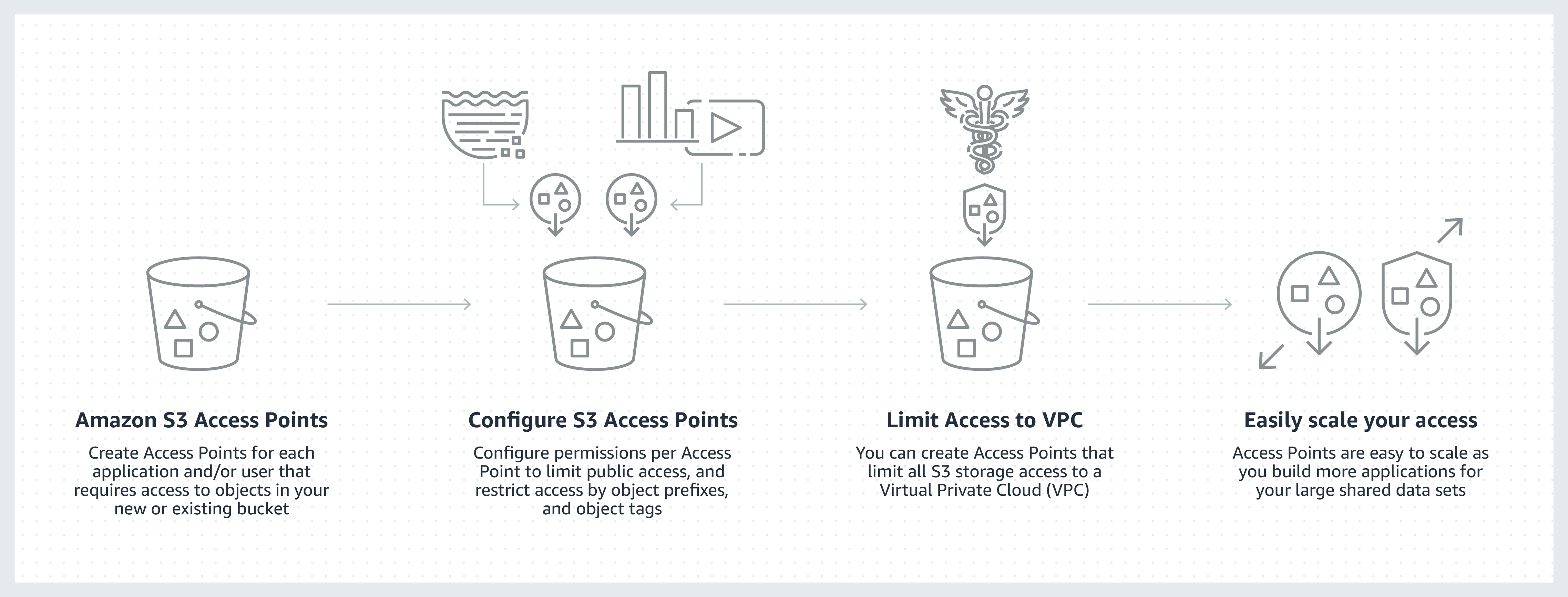Easily manage access for shared datasets on Amazon S3
Customers increasingly use Amazon S3 to store shared datasets, where data is aggregated and accessed by different applications, teams and individuals, whether for analytics, machine learning, real-time monitoring, or other data lake use cases. Managing access to this shared bucket requires a single bucket policy that controls access for dozens to hundreds of applications with different permission levels. As an application set grows, the bucket policy becomes more complex, time consuming to manage, and needs to be audited to make sure that changes don’t have an unexpected impact on another application.
Amazon S3 Access Points, a feature of S3, simplify data access for any AWS service or customer application that stores data in S3. With S3 Access Points, customers can create unique access control policies for each access point to easily control access to shared datasets. Customers with shared datasets including data lakes, media archives, and user-generated content can easily scale access for hundreds of applications by creating individualized access points with names and permissions customized for each application. Any access point can be restricted to a Virtual Private Cloud (VPC) to firewall S3 data access within customers’ private networks, and AWS Service Control Policies can be used to ensure all access points are VPC restricted. S3 Access Points are available in all regions at no additional cost.
How do S3 Access Points work?

Each S3 Access Point is configured with an access policy specific to a use case or application. For example, you can create an access point for your S3 bucket that grants access for groups of users or applications for your data lake. An Access Point can support a single user or application, or groups of users or applications within and across accounts, allowing separate management of each access point.
Every access point is associated with a single bucket and contains a network origin control, and a Block Public Access control. For example, you can create an access point with a network origin control that only permits storage access from your Virtual Private Cloud, a logically isolated section of the AWS Cloud. You can also create an access point with the access point policy configured to only allow access to objects with a defined prefixes or to objects with specific tags. If you wish to provide public access to your data using access points, you must turn off Block Public Access at the bucket level. All new buckets have Block Public Access turned on by default.
You can access data in shared buckets through an access point in one of two ways. For S3 object operations, you can use the access point ARN in place of a bucket name. For requests requiring a bucket name in the standard S3 bucket name format, you can use an access point alias instead. Aliases for S3 Access Points are automatically generated and are interchangeable with S3 bucket names anywhere you use a bucket name for data access. Every time you create an access point for a bucket, S3 automatically generates a new Access Point Alias. For the full set of compatible operations and AWS services, visit the S3 Documentation.
When to use S3 Access Points
S3 Access Points simplify how you manage data access for your application set to your shared datasets on S3. You no longer have to manage a single, complex bucket policy with hundreds of different permission rules that need to be written, read, tracked, and audited. With S3 Access Points, you can now create application-specific access points permitting access to shared datasets with policies tailored to the specific application.
- Large shared datasets: Using Access Points, you can decompose one large bucket policy into separate, discrete access point policies for each application that needs to access the shared dataset. This makes it simpler to focus on building the right access policy for an application, while not having to worry about disrupting what any other application is doing within the shared dataset.
- Copy data securely: Copy data securely at high speeds between same-region Access Points using the S3 Copy API using AWS internal networks and VPCs.
- Restrict access to VPC: An S3 Access Point can limit all S3 storage access to happen from a Virtual Private Cloud (VPC). You can also create a Service Control Policy (SCP) and require that all access points be restricted to a Virtual Private Cloud (VPC), firewalling your data to within your private networks.
- Test new access policies: Using access points you can easily test new access control policies before migrating applications to the access point, or copying the policy to an existing access point.
- Limit access to specific account IDs: With S3 Access Points you can specify VPC Endpoint policies that permit access only to access points (and thus buckets) owned by specific account IDs. This simplifies the creation of access policies that permit access to buckets within the same account, while rejecting any other S3 access via the VPC Endpoint.
- Provide a unique name: S3 Access points allow you to specify any name that is unique within the account and region. For example, you can now have a “test” access point in every account and region.
Whether creating an access point for data ingestion, transformation, restricted read access, or unrestricted access, using S3 Access Points simplifies the work of creating, sharing, and maintaining access to data in your shared S3 buckets.
How does AWS Data Exchange use S3 Access Points
AWS Data Exchange for Amazon S3 accelerates time to insight with direct access to data providers' Amazon S3 data. AWS Data Exchange for Amazon S3 helps you easily find, subscribe to, and use third-party data files for storage cost optimization, simplified data licensing management, and more.
Once subscribed, you are automatically granted access to the provider’s S3 bucket through a dedicated S3 Access Point managed by AWS Data Exchange. You can use the S3 Access Point alias to easily analyze the shared files with AWS services, such as Amazon Athena, Amazon SageMaker Feature Store, and Amazon EMR, without needing to create or manage data copies.
Visit the AWS Data Exchange for Amazon S3 product page to learn more.
Getting started with S3 Access Points
You can start creating access points, at no additional cost, on new buckets as well as your existing buckets through the AWS Management Console, the AWS Command Line Interface (CLI), the Application Programming Interface (API), and the AWS Software Development Kit (SDK) client. You can easily add, view, and delete access points as well as edit access point policies through the S3 console and the CLI. You can write an access point policies just like a bucket policy, using IAM rules to govern permissions.
You will also be able to use CloudFormation templates to get started with access points. You can monitor and audit access point operations such as “create access point” and “delete access point” through AWS CloudTrail logs. You can control access point usage using AWS Organizations support for AWS SCPs.
Visit the S3 Access Points documentation to learn more.

Get started building with Amazon S3 in the AWS Management Console.

